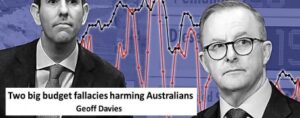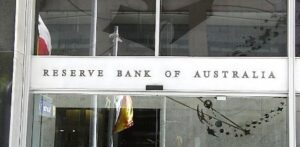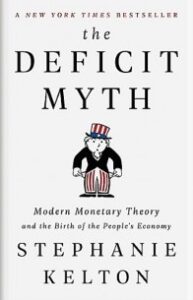Two big budget fallacies harming Australians
Geoff Davies

What if the federal budget is completely misconceived? What if we could avoid much of the hardship for ordinary Australians that is foreshadowed by the government?
Rational argument comes up hard against cognitive dissonance when questions like these are raised. People think ‘That can’t be right’. It is not plausible that all those experts could be so wrong. And who is this person, claiming to know better than the experts?
After all, the Treasurer is only saying what the experts have been saying for decades in such situations: at some point we have to reign in the deficit, and right now we have to slay the inflation dragon.
Here are two alternative propositions. First, the debt burden of the so-called deficit could be paid off tomorrow, and attempts at ‘balancing the budget’ only slow the economy and hurt the battlers more.
Second, battlers should be helped to deal with rising costs. Squeezing the economy with rising interest rates mainly benefits the financial sector and the wealthy, at the expense of ordinary Australians.
Let’s try some rational thinking, using documented facts and evidence.
First, the federal government, through the Reserve Bank, creates money. In order to accommodate a budget deficit, it could just spend that money into the economy, to pay for its many programs and policies. Instead, through a complicated and arcane process the government creates financial assets known as bonds, which are sold by the Treasury Department to primary bond dealers, which in turn facilitates spending by the government on its projects.
Those bonds pay interest to their owners, interest that must be paid by the government. In this way the government incurs debts to the private sector, and it is those debts that allegedly become a burden on ourselves and our descendants. They are not as big a burden as is usually claimed, because the interest can also be easily paid by the government, and the interest money flows into and ultimately benefits the entire economy.
But here’s the stranger thing: all of the money created by the Reserve Bank has no interest due on it. If the government just spent that money directly into the economy, instead of issuing bonds, the ‘deficit’ would not involve a debt servicing obligation.
One authority for these claims is the Bank of England [1], which spelt them out in a 2014 article, and also noted that many economists’ understanding of how banks work is incorrect.
Another authority is the US economist Stephanie Kelton [2], who explained at length, in her book The Deficit Myth, that a currency-issuing government never has to borrow money, because it is the source of money. The common analogy of a household budget, in which you must earn money before you can spend it, is quite wrong when it comes to the federal government: money must be created and spent into the economy before anything can happen, and before federal taxes can be levied.
The money has to come from somewhere. If all the money spent into the economy by the federal government was withdrawn through taxation there would be no net money supply, and the economy would come to a halt. So the inevitable trend is that the money created and spent by the federal government must exceed the money withdrawn through taxes.
Simple accounting reveals that money spent into the economy by the federal government increases the volume of money held by the private sector, aka the money supply. [In fact most of the money we use is created by private banks, who have a franchise to also issue money, but that doesn’t change the principle operating here].
It is more accurate and appropriate to talk about money supplied to the economy by the federal government, rather then a deficit in government accounts. The so-called government deficit is also the private sector’s surplus, which it can use constructively.

– Once you realize that trickle-down economics does not work, you will see the excessive tax cuts for the rich as what they are -a simple upward redistribution of income, rather than a way to make all of us richer, as we were told. ― Ha-Joon Chang –
The previous Australian federal government spent a lot of money during the pandemic, far more than it withdrew in taxes. That extra money kept the economy going, and saved the country from a major recession. The so-called “debt-and-deficit disaster” that some people claim is a consequence of all this additional spending is without foundation because such debt can be easily eliminated. The government could relinquish it using debt-free money created directly by the Reserve Bank. Then the ‘deficit’ would no long-er carry a debt obligation.
It would not be smart to eliminate all the debt in one go; it would be better to spread the process out over some time so that the financial markets had time to adjust to a new reality. We don’t need to support the unhealthy habits of the financial sector, but we do need to stop imposing unnecessary hardship on ordinary Australians.
Now to the second issue -the rising costs that are being called ‘inflation’. The problem is misdiagnosed and the remedy being applied only makes things worse.
One kind of inflation happens when more money is issued than is needed to run the economy. The extra money is then used to bid up prices. This has happened in the housing market, where the private banks have issued more and more money and so prices have inflated dramatically. The remedy for this kind of inflation is to slow the supply of money. This can be done by restricting the rate at which banks issued ‘loans’, as was done in Menzies’ day, or by raising interest rates, though this is a blunt instrument. Our present problem is not of this kind.
The problem is that many goods have become legitimately more expensive because of supply problems, due to the pandemic, war, floods and other natural disasters.
This has created a rise in the real cost of doing things: we must expend more effort to do the same things. It is not just a money supply problem.
If we increase interest rates and restrict government spending we only make things worse. The economy, already slowed by increasing costs, slows even more for lack of sufficient money. It is harder for ordinary people to get the money to buy what they need, and what they need costs more.
The main group that benefits from this approach is the financial sector. Their ‘assets’ are held notionally as dollars. If real prices rise, their dollars have less purchasing power, they devalue. However if prices are forced back down and money is ‘worth’ more because of higher interest rates, then financial assets hold their value. But everyone else is left to struggle even more.
The sensible approach is for the government to increase help to battlers, but this is ruled out because, it is claimed, there would be a boost to inflation. However it would not boost real inflation, because the problem at hand is in real supply lines, not in the supply of money.
It means the interests of the financial sector are put ahead of battlers. But generally those in the financial sector are already doing very well, and will not suffer if their fortunes decline a little, whereas the precariously employed struggle to pay for their kids’ schooling and may not even have enough for food, or a roof over their head.
Some economists do recognise the distinction between the two kinds of inflation. They speak of supply-driven and demand-driven inflation, but their jargon obscures the message and it has not cut through.

We are supposed to be a wealthy country. We do not need to tolerate poverty, and now homelessness. We can afford to ensure everyone has a dignified life. But we need to divest ourselves of some harmful myths before we can properly do that.
If you have not encountered some of these ideas before they may seem to contradict other things you thought you knew about the economy. You have to work through them to see they are part of a consistent story that is quite different from what we are seeing every day in the mainstream news. Stephanie Kelton’s book is a good place to start. And a more concise and approachable account is given in J.D. Alt’s book The Millennial’s Money [3].
- M McLeay, A Radia and R Thomas, Money in the modern economy, in Quarterly Bulletin. 2014, Bank of England, https://www.bankofengland.co.uk/-/media/boe/files/quarterly-bulletin/2014/money-creation-in-the-modern-economy.pdf p. 10.
-
S Kelton, The Deficit Myth: Modern Monetary Theory and How to Build a Better Economy. 2020, UK: John Murray. 325 pp.
-
Alt, J.D., The Millenials’ Money. 2016, Indianapolis IN: Dog Ear Publishing, http://www.dogearpublishing.net. 111 pp.
Source: Thrival Economics, 28 Oct 2022 https://thrivaleconomics.blog





























